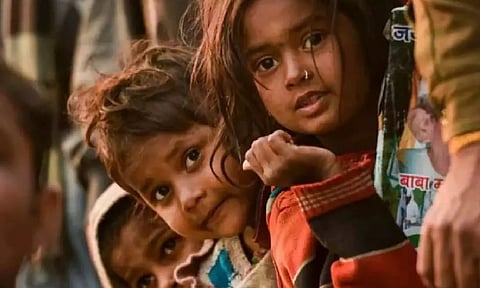

It’s illustrative of the mood swings of our nation that barely a week after going giddy with the success of the Chandrayaan-3 mission, we are plumbing new depths with the insensitive punishment meted out to an eight-year-old Muslim boy by his teacher in a school in Muzaffarnagar, UP. For the misdemeanour of failing to memorise a math table, the teacher ordained that the boy must receive punishment at the hands of his Hindu classmates.
As child after child stepped up to slap the weeping boy, she expressed disappointment that the slapping was not hard enough, and proceeded to pronounce her verdict on Muslim mothers: Muslim boys don’t do well at math, she said, because their mothers prefer going to their own mothers rather than helping their children with the homework. This bit of casual fascism has now become de rigueur in India under the BJP, particularly in UP, normalised by the relentless targeting of minorities by ruling party supporters.
Knowing the kind of administration UP has, we know that this too will be water off the duck’s back. This episode will play out the way all previous bouts of othering of Muslims have played out. Already, the parents of the student have preferred to pull him out of the school than to press charges against the teacher. The UP police, despite nationwide outrage, have arranged an ‘apology’ by the teacher and slapped the feeblest of cases against her, a charge of ‘mischief’ — no more than a slap on the wrist.
Law enforcement officials in UP buy time for the ruling party’s cover-up artistes to come up with obfuscations while the Adityanath government adopts an attitude of indifference. The Muzaffarnagar incident reflects our society’s normative acceptance of corporal punishment as a legitimate device to use against children, despite its universal rejection in other countries. This medieval practice remains lawful, taking off from Section 89 of IPC 1860, which says “nothing done in good faith for the benefit of a person under twelve years of age… is an offence by reason of any harm which it may cause.”
It’s a disgrace, giving parents and elders a power that they may not always wield to the child’s benefit. Even at school, we have no better protection for children from the kind of excesses teachers can commit in the name of discipline. While we have progressed some way towards prohibiting corporal punishment in schools, we are still in the ‘guidelines’ stage.
The “Guidelines for Eliminating Corporal Punishment in Schools” issued by the National Commission for Protection of Child Rights in 2007 are not binding. TheRight to Education Act 2009 does prohibit physical punishment or mental harassment of children but violators are only liable to disciplinary action under their service rules. Further, rules on corporal punishment vary from state to state, education being in the Concurrent List. Our law on corporal punishment tends to be recommendatory rather than mandatory. That is not good enough.
Research shows that such punishment remains prevalent despite all well-meaning guidelines. Eighty percent of children from marginalised sections receive physical punishment in one form or another. More than 90 per cent of parents are agreeable to it, and 50 per cent of teachers reported shaming students to discipline them.
The outrage over the Muzaffarnagar’s teacher’s gratuitous misuse of her power is welcome. But, the use of violence as an instructional aid in our schools comes from a deep reservoir of passive endorsement of it by society.